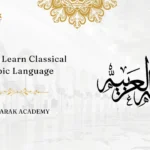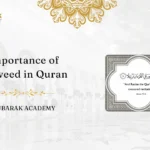Mastering a skill starts with a good grasp of its core. The core of reciting the Holy Quran properly is learning Makhraj, the art of articulating Arabic letters from their correct points of origin.
If you are interested in reciting the Quran with its clarity and beauty, let’s deepen your understanding of an essential lesson of Tajweed. What is Makhraj in Tajweed, and a detailed guide will be simply explained in this blog to ensure precise reciting.
What is Makhraj in Tajweed?
If you watch a video of the great reciter Mahmoud Khalil Al-Husary, paying attention to the movements of his mouth, you will notice how precisely he was eager to pronounce each letter correctly from its right Makhraj.
Coming back to our question, what is Makhraj in Tajweed?
Makhraj is the point of exit where each letter originates in the vocal tract, whether from the mouth or throat. Learning Makhraj is essential in Tajweed, which ensures correct recitation and that the divine message remains sound.

The Importance of Makhraj in Tajweed
As a non-native Arabic speaker, you will surely encounter some difficulties while trying to recite the holy Quran. Specifically, sounds that don’t exist in other languages.
You can avoid the hassle and start your journey by learning what is Makhraj in Tajweed, taking the right pathway to the perfect recitation.
- Learning the science of Makharij maintains the purity of the Quran’s pronunciation, as it was revealed to the Prophet Muhammad (peace be upon him).
- Enhancing the spiritual commitment to the Quran and feeling its meanings.
- Avoid falling into unintended errors due to mispronouncing some letters, like the words: (طين، تين). These words are mostly the same except for the first letter. If you mispronounce this letter, you will change the whole meaning, as the first word تين means fig and the second word طين means mud.
- Following the Prophet’s Sunnah. The Quran was transmitted orally before being written; our Prophet (peace be upon him) and his companions recited the Quran with meticulous care, maintaining the right Makharij of the letters.
- By learning what is Makhraj in Tajweed, you pave the way to a good grasp of the Quran’s meanings and vocabulary.
How Many Makhraj are There in Tajweed?
The Arabic letters are 28; each one of them has a certain Makhraj. Such Makharij are categorized by scholars of Tajweed into 17 distinct points, grouped into five major origins:
- Makharij Al-Jawf: ا, و, ي (madd letters)
- Makharij Al-Halq: ء, ه, ع, ح, غ, خ
- Makharij Al-Lisan: ن, ر, ت, د, ط, ج, ش, ي, ق, ك, etc.
- Makharij Ash-Shafatan: ب, م, و, ف
- Makharij Al-Khayshum: Ghunnah (ن, م in specific rules)
These five areas are the major regions in our vocal tract where Arabic letters are produced. We will explain below in detail each one of them and how to produce it correctly.
The 5 Main Makhraj In Tajweed
After clearing up what is Makhraj in Tajweed and how many Makhraj we have in the Arabic language, let’s dive into these articulation points and learn how to produce them:
1. The Throat (Al-Halq):
The throat produces six letters depending on the point of articulation in it, which can be categorized into these 3 points:
- Deepest Throat: Letters hamza and ha / ء ه.
- Middle Throat: Letters ‘ayn and ha / ع ح.
- Upper Throat : Letters ghayn and kha / غ خ
Such letters need control over throat muscles to produce the proper sounds of them.
2. The Tongue (Al-Lisan):
The tongue is the ultimate controller of the Arabic letters, which is responsible for 18 letters, here are some of them:
- Tip of the Tongue: Letters like noon, ra, and ta /ن رت .
- Middle of the Tongue: Letters like jeem, sheen, and ya /ج ش ي .
- Back of the Tongue: Letters like qaf and kaf / ق ك .
Thanks to the tongue’s flexibility that makes it produce the largest number of letters, you can adjust your reading perfectly by learning the right sounds of the tongue Makhraj.
3. The Lips (Ash-Shafatayn):
Mastering lips movement is easy yet crucial to adjust the 4 letters that the lips are responsible for:
- Between the Lips: Letters ba, meem, and waw / ب م و .
- Lower Lip and Upper Teeth: Letter ف / fa .
4. The Nasal Passage (Al-Khayshoom):
This is the Makhraj for the nasal sound that followers letters like ن (noon) and م (meem) in specific Tajweed rules, which is called غُنَّة (ghunnah). This is a crucial sound that has an impact in the flow of reciting.
5. The Oral Cavity (Al-Jawf):
Madd letters (ا alif, و waw, ي ya) are ultimately produced in this place. They are the elongated sounds that are originating from the empty space in the mouth. Deepen your knowledge of this rule and read what is Madd in Tajweed.
Difference Between Makhraj, Tajweed and Sifaat
Learn Makharij al Huruf with Mubarak Academy
Learning what is Makhraj in Tajweed is a great skill to master the rest of the Tajweed rules effortlessly. With meaningful resources and expert teachers, the learning process will be easier than before. All you need to do for now is check our Tajweed Rules and try the free session to take the first step in mastering reciting the holy Quran.
Conclusion
Knowledge is the best way to master any skill, that’s why you should make sure you are receiving the right knowledge, which is fundamental in your journey. Tajweed ensures that every word you say is well pronounced as it was revealed to Prophet Muhammad (peace be upon him) to ensure the rewards of this life and the hereafter. Mubarak Academy is the reliable Online Quran Academy that makes your learning accessible and fruitful.
Frequently Asked Questions
1. What are Practical Steps While Learning Makhraj in Tajweed?
You can start with listening to reciters, imitating them exactly, and practicing in front of the mirror to be able to evaluate your progress.
2. How Long Does it Take to Master Makhraj?
It depends! With consistent practice and structured lessons you can accomplish good results within a few months.
3. Is it Hard To Learn Tajweed for Non-Native Speakers?
No, learning in the right way with qualified teachers, such as Mubarak’s teachers, who can facilitate approaches to learn.




